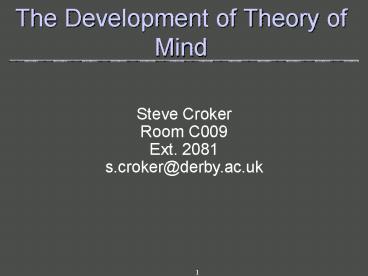The Development of Theory of Mind - PowerPoint PPT Presentation
1 / 18
Title:
The Development of Theory of Mind
Description:
1. The Unexpected Transfer Test (e.g. the Sally- Ann Task, Frith, 1989) ... Taylor & Mitchell, 1996. 13. 14. New Theories of ToM' Modularity Theory: ... – PowerPoint PPT presentation
Number of Views:52
Avg rating:3.0/5.0
Title: The Development of Theory of Mind
1
The Development of Theory of Mind
Steve Croker Room C009 Ext. 2081 s.croker_at_derby.ac
.uk
2
Outline
- What is Theory of Mind?
- Issues in the Development of Theory of Mind
- Cognitive Deficit (Stage) Theory of Theory of
Mind - Support for Cognitive Deficit Theory
- Criticism of Cognitive Deficit Theory
- Alternative Theories
- Theory of Mind in People with Autism
3
What is Theory of Mind (ToM)?
- Peoples common sense knowledge about others and
their own mental activities (Lee, 2000). - Allows us to read anothers mind
- i.e. guess what they are feeling, perceiving,
desiring, intending, knowing and believing - e.g .
- John gave Rebecca a box with Candies written
on it. Unknown to Rebecca, John had removed the
candies and replaced them with a pencil - What does Rebecca think is in the box?
4
Development of Theory of Mind
- 2 issues
- When and why do children develop understanding of
the minds of others? - When and why do children develop the ability to
distinguish appearance from reality?
5
The Traditional ViewCognitive Deficit Theory
- Dominated ToM research for many years
- Based on Piagets idea of egocentrism
- ToM is not acquired until there is a radical
shift in our thought processes (Perner, 1991) - ToM illustrates a stage-like qualitative change
in thought processes. - Children under 4 years of age do not have a
Theory of Mind
6
Support for Cognitive Deficit Theory (1)
- False Belief Tasks
- 1. The Unexpected Transfer Test (e.g. the Sally-
Ann Task, Frith, 1989). - 2. The Deceptive Box Test (e.g. Perner, Leekam
Wimmer, 1987). - Appearance-Reality Tasks
- The rock/sponge experiment (e.g. Flavell, Flavell
Green, 1983).
7
(No Transcript)
8
(No Transcript)
9
Support for Cognitive Deficit Theory (2)
- Cross-cultural Studies
- e.g. Avis Harris (1991)
- Baka tribe of pygmies
- unexpected transfer test
- those under 5 years of age failed
- those over 5 years of age passed
10
Criticisms of Cognitive Deficit Theory (1)
- 1. Over-reliance on False Belief Tasks
- False Belief Tasks are flawed
- Children misunderstand the question (e.g. Lewis
Osborne 1990) - Difficulty understanding and integrating key
elements of the story, (e.g. Lewis, Freeman,
Hagestadt Douglas, 1994) - Children do not know that seeing is believing
(e.g. Wimmer, Hogrefe, Sodian, B. 1988).
11
Criticisms of Cognitive Deficit Theory (2)
- 2. Naturalistic studies suggest young children
are good at ToM type tasks - Childrens ToM develops slowly over a number of
years - Dunn, 1988
- disputes, jokes, prosocial behaviour,
cooperation, pretend play, conversations - Chandler, 1988
- treasure hunt studies
12
Criticisms of Cognitive Deficit Theory (3)
- 3. Evidence of ToM failure in older children and
adults - Steverson, 1996 (unpublished)
- Fischhoff, 1975
- 4. Evidence of being deceived by reality in
adults - Taylor Mitchell, 1996
13
(No Transcript)
14
New Theories of ToM
- Modularity Theory
- A ToM MODULE (Scholl Leslie, 1999)
- Bias towards paying attention to reality
(Mitchell, 1997) - Gradual build up of knowledge of the world
(Chandler, 1988)
15
ToM in People with Autism (1)
- What is autism?
- Difficult to define
- Characteristics of autism (National Autistic
Society) - difficulty with social relationships
- difficulty with verbal communication
- difficulty with non-verbal communication
- difficulty in the development of play and
imagination - resistance to change in routine.
16
ToM in People with Autism (2)
- Characteristic of autism
- failure to develop ToM
- Seems restricted to autism (Baren-Cohen et al,
1985) - Theories of ToM must explain this
17
Conclusion
- ToM develops throughout childhood
- Exactly when ToM develops is disputed
- Cognitive deficit theorists - age 4, sudden stage
like change - Others - earlier/later, gradual change
- Evidence theories must explain
- experiments on children and adults
- naturalistic data
- people with autism
18
Learning Outcomes
- Critically compare and contrast different
theories of ToM - Critically evaluate the research conducted
- experiments on children and adults
- naturalistic data
- Critically discuss the role of ToM in autism































